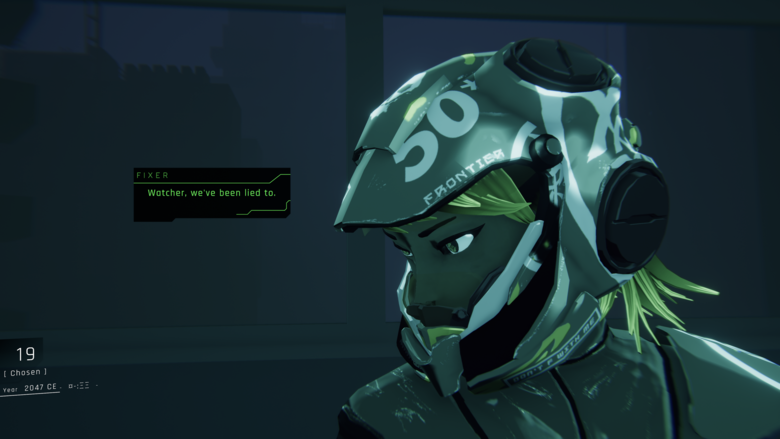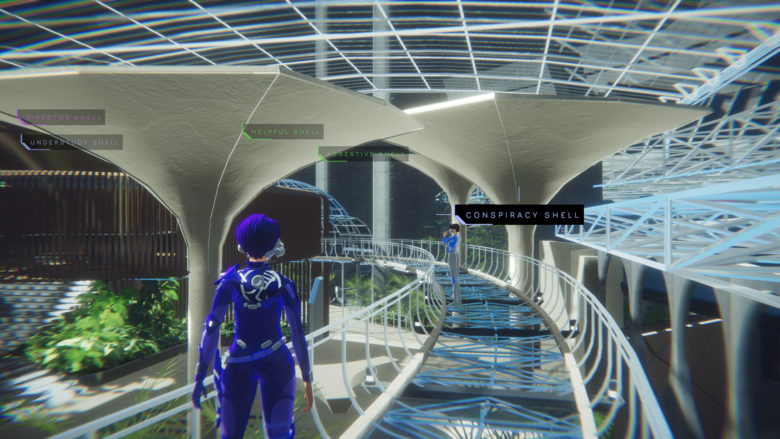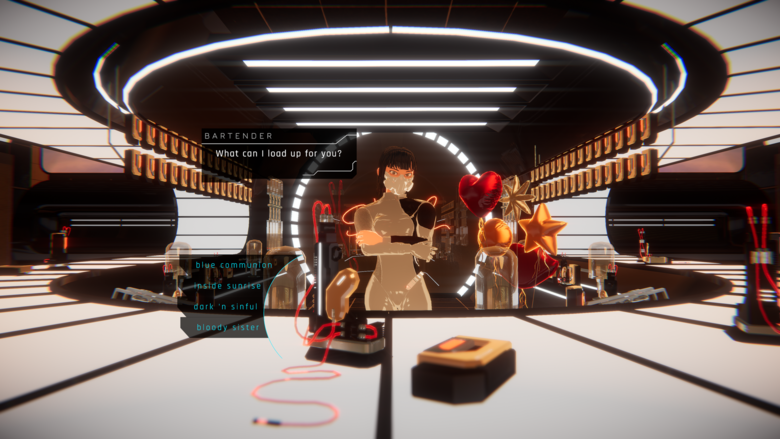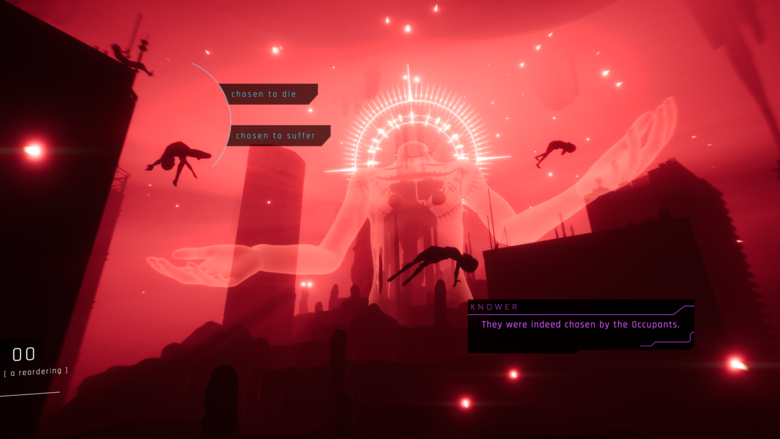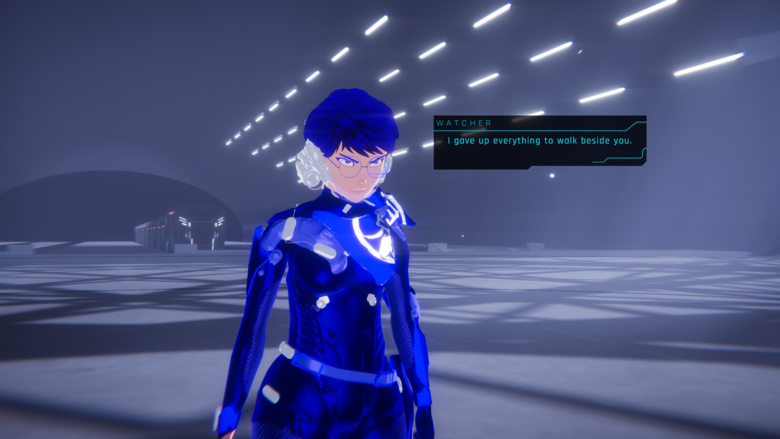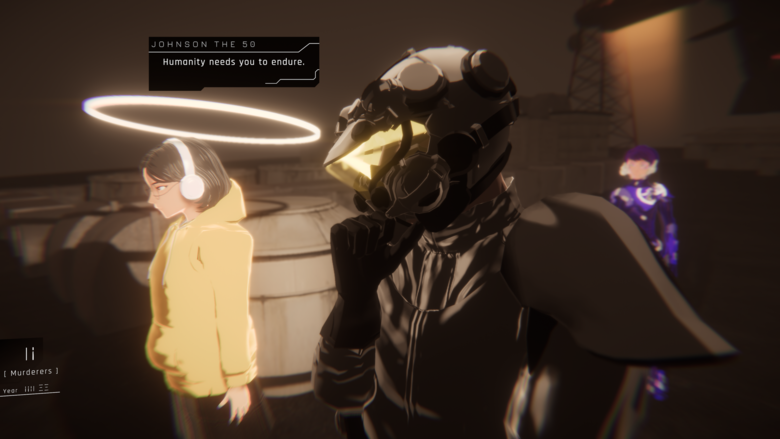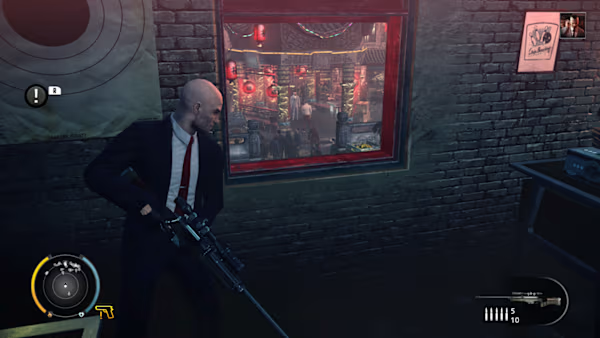INTERVIEW: How sunset visitor tackled 1000xRESIST, a genre-defining experience
1000xRESIST is a game I had on my radar thanks to some intriguing trailers leading up to the game’s launch. I was eager to jump into the experience when it launched May 9th, 2024, but I had no idea it would end up becoming if not my favorite game ever, easily a title in my top 3.
It’s not often that you find a title that challenges your gaming Mount Rushmore. Most of my favorites have been cemented for decades now, and while I’ve enjoyed plenty of fantastic games in my 35+ years of gaming,1000xRESIST far surpasses just about everything else I’ve encountered. Truth be told, my playthrough of 1000xRESIST has been so impactful that I’ve found it hard not to just play other games, but engage with other entertainment since. It’s just that damn good.
If you listen to the GoNintendo Podcast, you know I haven’t shut up about 1000xRESIST since I first started playing. I chronicled my journey through the game (spoiler-free) for a couple of weeks, and then gushed on and on about the earth-shattering experience I found it to be. I did my best to turn that praise into a written review, but I still feel what I put together doesn’t do the game anywhere near the justice it deserves. Even now I feel completely inadequate in writing this preamble, as I can’t shake the idea that no matter what I say or how I say it, the words I come up with will fail to convey just how meaningful I believe 1000xRESIST to be.
Since I feel utterly incapable of expressing just what 1000xRESIST is and aims to do, I thought who better to handle those topics than the dev team? I have been incredibly lucky to link up with Remy Siu, Creative Director at developer sunset visitor, in order to get the ins, outs, highs and lows of building 1000xRESIST. Read on below to learn all about how this brand-new studio managed to craft what I consider to be easily one of the industry’s finest titles.
GN: How big is the 1000xRESIST team?
RS: Not very big! Our main development team consisted of 4 people. 2 writers working part-time, also still doing performing arts things. 2 composers. We had about 3 contractors working on their own timelines and/or a part-time basis.
GN: When did development on 1000xRESIST first start?
RS: I started working on the prototype in March/April 2020, pretty soon after the COVID-19 lockdown in Canada. After creating a prototype, finding funding, and a publisher, the company was born into production. We rebooted the project and started from scratch on June 1st, 2021.
GN: 1000xRESIST is Sunset Visitor’s first game. Releasing such a layered experience as your first title seems incredibly daunting. How did you keep track of everything during development?
RS: Yes, it was very hard. I think many times during development, the writing team felt crushed by the mounting narrative weight. I certainly did.
We had a big MIRO board where we kept track of as many things as we could, such as the chronology, themes, scene ideas, and formal ideas. At the same time, we would try to make space for ourselves to play within all these things that were happening in the narrative, so if we needed to, we could make hard left turns when we thought necessary.
One of things that helped was the writing team and I had worked together for nearly 15 years at this point, in different capacities. In the performing arts, we largely practiced something called “devised performance,” which involved us trying to create a performance with whoever and whatever was in the room, through structured play and improvisation. Often we didn’t have a script, so there was never really a “written down” blueprint. Over time, we got better at keeping all these things afloat in our heads. Eventually, some of the work we did started drifting toward more fictional/writing contexts where we tried to apply the same methods.
GN: As 1000xRESIST is a narrative adventure, story is paramount. What kind of work went into wrangling all facets of the story?
RS: A lot of work, hahaha. I think after a while, a method we started to use was something we called “loose leafing.” The writers and I would go off and create “loose leaf” scenes, just any type of scenes we thought were interesting inside of a conceit or chapter. From there, we’d have an abundance of scenes that I would filter and edit as I implemented them into Unity, and built the chapter flows.
We did this because trying to dictate what scenes were necessary, and how they may be approached, before the “level” was being created was almost impossible. Something would always change or become redundant. Maybe something was made really clear with a camera shot and a line of dialogue was no longer necessary. Or a whole scene was no longer necessary.
As writers, we’re kind of “gardeners,” and think by writing, as opposed to plotting. This kind of “loose leaf” approach helped with that. Usually, we eventually start writing scenes that are interesting to us.
There is one section near the end of the game [spoilers] near the mother and Iris stairwell scene [/spoilers] that had like 30 loose leaf scenes that were cut.
GN: Is there a singular “lore master” for 1000xRESIST? Someone who ensured everything worked story-wise with everything else, or was it a team effort?
RS: While we all tried to check each other, keeping each other from breaking established “canon,” I largely served as the unofficial lore master. Which gave me the…hugely popular…job of saying things like, “ah, yeah, unfortunately, this wouldn’t work in what we’ve set up.” Or “X contradicts Y.”
We were really trying to keep things grounded in our own rules – even if we weren’t doing “hard sci-fi,” we tried to adhere to the in-world rules as much as we could. If you start to mess with that too much, you lose the audience’s trust, I think.
GN: Just how big is the story and script for 1000xRESIST? What’s the final pass like size-wise compared to the initial draft?
RS: I think the final script was around 80,000 words with around ~15,000 lines of dialogue. I think that’s not THAT many words for a game, even an indie game. However, our style with dialogue is not super verbose. I do think we pack a lot of story into those 15,000 lines of dialogue. It feels like a lot to us, because we also had to record all those lines, and I know that is rarer for an indie game.
We never had an “initial draft,” since we made the game chapter by chapter. It was always an evolving, rolling thing. We would be building/implementing the chapter in Unity, while some early “loose leafing” was happening on the next chapter. And those loose leaf scenes would often change after the current chapter was completed-ish.
I think at least 30,000 words were left on the cutting room floor.
I will say the game turned out bigger than we thought it would be, at the start. Much of that was like, okay, we have a general thought about where we’re going at any given point in time, but as we were discovering how to get there, and how to make the pacing feel good, things would expand (and contract!).
GN: The way that 1000xRESIST comes together is absolutely breathtaking, and is no doubt one of the greatest achievements in narrative adventures. Were there moments during development where it felt like the project was too grandiose to harness?
RS: Yes. The ending nearly crushed us as writers. There were many times where we didn’t really know what to do. This is a result of – we did a lot of “leaping” into the unknown, because it was exciting to us, it made us excited as writers to write those scenes. Of course, at one point we had to end it, or do a “season finale.” Figuring out how to get that last chapter to do all the things it does, was a very painful and scary process.
This was magnified by the fact we took a very different angle with the second half of the game. The first half is a little more, “communion of the week,” and the second half just starts to break that down and become more ambiguous. The length of chapters became less uniform. It didn’t wrap up with you having a “capstone” conversation with one of your sisters at the end of a communion. We were actively moving into a more “desperate” space as writers, mirroring the desperation of the situation in the second half. I think it also got more character driven/focused in the second half.
We didn’t know what to do, emotionally beat-wise, after CH7. CH7 turned out the way it did and we did playtests, and it was doing something to the players. I think it felt somewhat cathartic in a way we didn’t anticipate, so pacing wise we had to deal with the fallout of that.
That being said, perhaps, our active struggle with it, gave the work energy it wouldn’t otherwise have. I’m glad that people are resonating with the way it came together!
GN: 1000xRESIST is an extremely emotional story. How did the team handle telling such an earnest, heart-wrenching tale?
RS: We were always trying to be as emotionally honest, to the best of our ability. We would also try to let that emotional honesty change or swerve the plot. We wanted each scene to feel emotionally grounded, tell you something about the characters and state of the world, and we wanted to do this all at once without being too direct with it.
I think we had the space to do it, because we subtracted almost everything else to make space for it. There’s no combat, there’s no mini-games really, there’s no quick-time events, etc. Largely you do what people may do in the presented scenario, which is moving from one place to another, speaking to one another. Lying to each other.
I’ve read some people saying that “the story is really good and impactful, but there’s not that much gameplay,” which I understand. I do think that cutting any gameplay that didn’t make sense in any given scenario was largely why we had space to make certain things impactful. We had space to play in other ways.
GN: There’s no doubt topics tackled in 1000xRESIST are deeply personal for some of the team members. Does the game serve as an amalgamation of real-life experiences the team has gone through?
RS: I would say in some ways, yes. But only bits and pieces, that we would take the energy from and inject into the fiction. Especially when it came to the diasporic elements of the story. We would draw from our own experiences to understand how to write these scenes, or find a specific interesting angle to us.
Of course none of us have ever committed some of these things depicted in the game, but we would always try to colour scenarios or actions from this diasporic lens.
GN: What made you feel that going the narrative adventure route was the way to approach 1000xRESIST? Were there ever any thoughts about including more traditional game elements?
RS: When I was working on the prototype it was the only thing I felt I could really lean into. I wasn’t a very experienced Unity programmer, nor was I able to 3D model things myself, so I had to lean into the story element. I also really love narrative adventure games, those are really the games I play, so it made sense.
When we rebooted and started production anew, we had a meeting at the beginning and said “we are making a narrative adventure game.” We really wanted to focus on the fact that this game follows the lineage of Grim Fandango, Kentucky Route Zero, Gone Home. KRZ was point-and-click without the puzzles. Gone Home was this Bioshock-like environmental storytelling without the gun. We wanted to take from those what we really enjoyed and tried to continue with it.
Much has been said about “walking simulators” – and in many ways, this game can be classified as one – but I think one big difference we actively tried to follow was: no tapes, no reading of books, no looking at photographs, in that walking simulator style. We wanted to have the story, actively happening “to” you or “at” you, as opposed to you exploring the detritus of a story.
GN: 1000xRESIST is available on PC, but as far as traditional platforms go, it’s only on Switch. What made you target Switch for this release?
RS: It was an important market for the publisher, hahaha. Also, it’s a great market for indies! A great platform for indies.
Also, many of our artist friends and people we know – they use Macs. If they had any gaming device, it would be the Switch (Animal Crossing really helped with that).
I also really like that the Switch is often played in a kind of “nook” venue, you would play it much like you would read a book. Maybe on the couch or in the bed. I think story games really make sense in that context.
This decision was made before the Steam Deck was announced to the public. Really curious about Switch 2, hoping we can get near Steam Deck levels of performance, whenever those details are announced!
GN: How nerve-racking is it to release your first game, especially when it’s one that takes such a ginormous swing from a narrative standpoint?
RS: Very nerve-racking. Many times, we were like, oh man what are we doing. Making a game so narratively focused, to the extreme? It’s not a straight survival horror game, it’s not a rougelike – it’s not wholesome – it’s not a deckbuilding, card thing. There’s no cat. There’s no gun. There’s no heroes. There’s largely no puzzles. No objects to look at, so when you turn them around, something is written on the back of them. Not a lot of branching. No one “remembers you said that.” Also, a lot of narrative focused games borrow the VN style of dialogue presentation (Hades, etc.), and we don’t even have that! You can’t look at a screenshot and be like, oh this game has cute portraits of the people who talk. We also had to hide a lot of the narrative swings, as they’re super spoilery.
People are going to say it’s not a game! (People have said that, but thankfully, they still come to like it). And yes, we were really thinking about it as a kind of experience you could only have in an interactive, software medium – but not exactly a “game” – won’t open that can of worms here. But that difference was not obvious and largely experiential. It was about your distance as the player to the character, your distance as a player to the events that were happening, closing that distance or widening it. Spending time in spaces. Experiencing duration.
It’s also not representation in a way where you get to see someone that looks like you also shoot and kill someone and say something witty. Or double jump. (Not to say those things aren’t important, they are. Since those are the main verbs in so many games, it should not be a narrow domain for representation). We wanted to get into some of the uglier parts of being diaspora and not sanitize it.
I think a lot of the risk was not doing those things and trying to make as much space as possible for the narrative to breathe. Trying to believe that there is so much more to this medium than “Mechanics.” That there’s still so much to explore, in the cracks.
To try and make it interesting to ourselves and others was a journey with a lot of doubt, to say the least, hahaha.
GN: Before its release, what did you think the reaction to 1000xRESIST would be? For the people and press who’ve played, it’s been skyhigh universal praise to a degree I can’t ever recall seeing. Obviously all developers hope for that kind of reception, but just how taken aback were you by the initial reaction?
RS: I was hoping people would look past the “not game enough” aspect and get to the surprises! We really wanted to share where we got with it. Hoping people would stick with it and find out.
I think we’re pretty floored with the reception that we’re getting. I think people started meeting the game where it was coming from, way sooner than I thought. We’re also really, really grateful to everyone who has spread the word about the game, and all the really thoughtful new fans, some of whom are writing these really amazing posts. And making really amazing fan art!
One of the most rewarding things, I think, is learning more about what we made from the audience now. They’re finding things, reading into things, in ways that are new to us. That’s really rewarding and wonderful.
GN: The voice cast for 1000xRESIST is stellar, adding serious depth to the story. How did you go about finding the actors and getting such meaningful performances out of them?
RS: We cast the main characters before we started writing in earnest. We really wrote “into” the voices. We’re used to “assembling the ensemble” first, then working with them. Some of these performers are new to us – like Nhi Do, who plays Watcher, what an amazing discovery for us – and some are performers we’ve known for years, and worked with before.
I think the biggest part of getting these performances was making sure the dialogue had space for them to work. That the line itself was not being too prescriptive with how it needs to be said. Or that a scene could be played in multiple ways. The second part of that was always turning down the dial, to remove expectations that they may have of what we wanted, and then work from there!
GN: Much like the voice cast, the soundtrack for 1000xRESIST is a stunning achievement. How big was that team and just how long did they spend crafting the game’s music and sound? How much did they have to go off of when working on tracks?
RS: There were two composers, Line Katcho and Drew Redman, and one audio engineer, Justin Aucoin, on the audio side. I think they were working on and off on the soundtrack for two years. Much of the time, they were writing music for parts of the game that were already made. So they were able to play through the whole parts, before writing the music. They all really knocked it out of the park!
Fixer’s Song is used in the game’s trailer and it also pops up in the game itself (in a personal favorite moment of mine!). It’s such a beautiful, sad and heartfelt song. How did that tune in particular come about, and what’s the musical background for the track’s singer?
We knew Fixer had to sing a song there, but for the longest time, we didn’t have a song. Alex Mah, who was also helping us record voice on and off, was also a composer and songwriter. He was working on another project with Pinki Li (one of the writers) that I was also involved in, and he wrote this song. It was very longing and sad, as you say. I always kept that in my head, because we knew we wanted Fixer’s voice actor to sing a song, because she’s a music artist as well.
We asked Alex, can we use that song, and let’s re-write the lyrics together? Once we did that, Drew (one of the composers) took it and arranged it for piano. And then, we decided to use the song for the trailer!
I don’t know when this interview will be printed, but we’ll be releasing an EP very soon with an extended piano version, a “live” guitar version, and the in-game version. (Album is now available to stream at this link)
GN: What does the team hope players take from 1000xRESIST, and how has it been seeing people discuss meaning and metaphors since release?
RS: It’s been wild seeing people discuss the game and unpack it. Geeks and Grounds is currently doing 1000xRESIST as their June game of the month (a kind of video game book club!), and they are doing podcasts every 3-ish chapters. Other players are playing along with them, stopping each week. This kind of thing is so amazing to me, because they get to experience it a bit like a TV show!
Also, seeing people talk about it on ResetEra, the Fellow Traveller Discord, and other places, has been a surreal experience in the best way.
I think thematically, I want to leave this open for people to read into. However, one of the things I hope players takeaway is the “energy” of the narrative, that we really tried to push it, that we really tried to take risks, and that stories can be messy and strange, and strangely shaped, and that’s the fun of it.
GN: You’ve created a massive world and incredible cast of characters with 1000xRESIST. Is this the last we’ll see of this universe, or could there be more down the road? A direct sequel? A spin-off? Perhaps off-shoots like a comic book or traditional novel?
RS: I have many ideas about what will come next. And an idea that’s nagging at my brain, that could be a really mind-bending way to pick up where we left off. It may be wild to say, but there are more topics we’d like to cover.
I do really want to return to this universe – I love it a lot – but I think we need to have some time away, before coming back. Learn some other things. It will be better for it, if we ever do.
…all that being said, buying the game, telling your friends about the game, and leaving a review on Steam always helps to nudge that into being a possible reality! I would love the chance to continue these threads, hahaha.
GN: Are there any plans for a physical release or special edition down the road?
RS: There are currently no plans at this time. But…yeah, I will definitely keep you informed.
A huge thanks to sunset visitor in general and Remy Siu in particular for taking the time to chat with me about 1000xRESIST. The game is available right now on both Steam and the Switch eShop. If you’d like to learn more about 1000xRESIST in general, make sure to check out the official Nintendo.com page.

